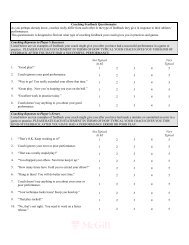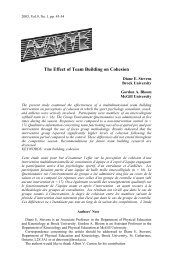International Journal of Sport Psychology
International Journal of Sport Psychology
International Journal of Sport Psychology
You also want an ePaper? Increase the reach of your titles
YUMPU automatically turns print PDFs into web optimized ePapers that Google loves.
scriptions, independently identifying raw data themes for the impacts/benefits <strong>of</strong> producing<br />
athlete performance pr<strong>of</strong>iles. Twenty impact themes were established via the triangular consensus<br />
from 54 raw data themes. A review <strong>of</strong> the pr<strong>of</strong>iling literature revealed 15 performance<br />
pr<strong>of</strong>iling impacts. Following an examination <strong>of</strong> the interview and literature review pr<strong>of</strong>iling<br />
impact themes, three researchers agreed upon the 24 items to be included within the questionnaire.<br />
Combining literature review and interview analysis procedures to develop items for<br />
a questionnaire in this way, is in line with approaches adopted elsewhere in the literature<br />
(Weinberg, Burton, Yukelson, & Weigand, 2000; Yoo, 2000). Survey impact items displayed<br />
good internal reliability (α=.94).<br />
DATA ANALYSIS<br />
Descriptive statistics were taken to determine the mean (& standard deviation)<br />
responses regarding the usefulness and benefits <strong>of</strong> pr<strong>of</strong>iling within a group setting.<br />
Results<br />
Descriptive statistics indicated that consultants found performance pr<strong>of</strong>iling<br />
to be useful (M = 4.27, SD = 0.79). Table 1 outlines the descriptive<br />
results for the consultant perceived impacts <strong>of</strong> performance pr<strong>of</strong>iling. Multivariate<br />
analysis <strong>of</strong> variance revealed no significant gender differences for the<br />
impact items (Wilks’ λ = .654, F(24, 17)= .375, p=.986, η 2 = .35, β = .16).<br />
Discussion<br />
The present findings indicate that BASES accredited sport psychology<br />
consultants strongly believed performance pr<strong>of</strong>iling to be useful, thus confirming<br />
previous research (Butler & Hardy, 1992; Dale & Wrisberg, 1996;<br />
D’Urso et al., 2002). In particular, the consultants believed pr<strong>of</strong>iling to be<br />
most useful in helping provide a basis for goal setting, identifying the athlete’s<br />
strengths and weaknesses, raising athlete self awareness, facilitating discussion<br />
within the team, and helping the athlete focus on what’s important.<br />
The least important impacts <strong>of</strong> pr<strong>of</strong>iling in a group, rated moderately by the<br />
consultants, related to the technique’s ability to encourage independent<br />
thought and make athletes more accountable.<br />
Butler and Hardy (1992), in introducing the pr<strong>of</strong>iling procedure, suggested<br />
that the process <strong>of</strong> raising the athlete’s awareness regarding the qualities<br />
essential for elite performance and the athlete’s ability in relation to those<br />
qualities, would help provide a useful basis to set goals. Goal setting in sport<br />
364




